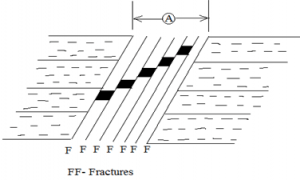This set of Engineering Geology Questions and Answers for Experienced people focuses on “Fault Terminology – 02”.
1. A fault has how many walls?
a) 1
b) 2
c) 3
d) 4
View Answer
Explanation: In faults, the concept of walls is very important and must be understood very clearly. In a rock body, when a fracture takes place, it divided the rock into two parts or two blocks.
2. It is easy to locate older and major folds.
a) True
b) False
View Answer
Explanation: It may be easy to locate fault planes or fault surfaces in small scale and in rather recent faults. In older and especially major faults spreading over miles of area, however, extensive field work including drilling or subsurface investigations using geophysical methods may be required to determine these structures.
3. What is the block which suffer displacement in faulting called?
a) Walls
b) Parts
c) Sections
d) Blocks
View Answer
Explanation: The blocks which suffer displacement and stand on either sides of the fracture are called as walls. Generally there exist two types of walls, hanging wall and foot wall.
4. The block which lies on the under surface of fault plane or zone is called ___________
a) Hanging wall
b) Sub-wall
c) Foot wall
d) Lower wall
View Answer
Explanation: The term foot wall is used for that faulted block which lies on the under surface of the fault plane or zone.
5. Who coined the terms “hanging wall” and “foot wall”?
a) Scientists
b) Geologists
c) Engineers
d) Miners
View Answer
Explanation: Actually the terms “hanging wall” and “foot wall” have been coined by the miners: while traversing along a track excavated in fault plane, the wall under their feet would be foot wall whereas the other block would hang above their heads.
6. What is a small region with definite thickness and distinct composition having numerous closely placed parallel fractures called?
a) Shear zone
b) Fault zone
c) Fracture zone
d) Slikensides
View Answer
Explanation: Fault zone is a small region with definite thickness and distinct composition having numerous closely placed parallel fractures within itself along which there have been clear displacements.
7. What is the nature of displacement in shear zone?
a) Ductile
b) Brittle
c) Malleable
d) Sonorous
View Answer
Explanation: The displacements in shear zones are generally ductile in nature compared to brittle fracturing in simple faults or fault zones.
8. Identify the part labelled as “A” in the figure below.

a) Shear zones
b) Fracture zone
c) Fault zone
d) A-zone
View Answer
Explanation: We can observe numerous parallel placed fractured blocks in the shown region and this is possible in a fault zone. The picture depicts fault zone with distinct thickness and closely placed parallel fractures.
9. Slip is expressed in terms of ___________
a) Millimetres
b) Metres
c) Kilometres
d) All the three
View Answer
Explanation: The slip is defined as a relative displacement of any points that were formerly contiguous to each other, as measured along the fault plane. It may be expressed in millimetres, metres or even kilometres.
10. The type of slip not considered for study is ___________
a) Strike slip
b) Dip slip
c) Hade slip
d) Oblique slip
View Answer
Explanation: The slip is further distinguished on the basis of the direction of displacement with respect to the fault as dip-slip, strike-slip or oblique slip. Hade slip is not one such.
11. What is the vertical component of dip separation called?
a) Offset
b) Throw
c) Heave
d) Strike gap
View Answer
Explanation: Throw is the vertical component of the dip separation measured in the direction perpendicular to the strike of the fault in a vertical plane.
Sanfoundry Global Education & Learning Series – Engineering Geology.
To practice all areas of Engineering Geology for Experienced people, here is complete set of 1000+ Multiple Choice Questions and Answers.
If you find a mistake in question / option / answer, kindly take a screenshot and email to [email protected]
- Apply for Mining Engineering Internship
- Check Engineering Geology Books
- Practice Civil Engineering MCQs
- Apply for Civil Engineering Internship
- Check Mining Engineering Books
